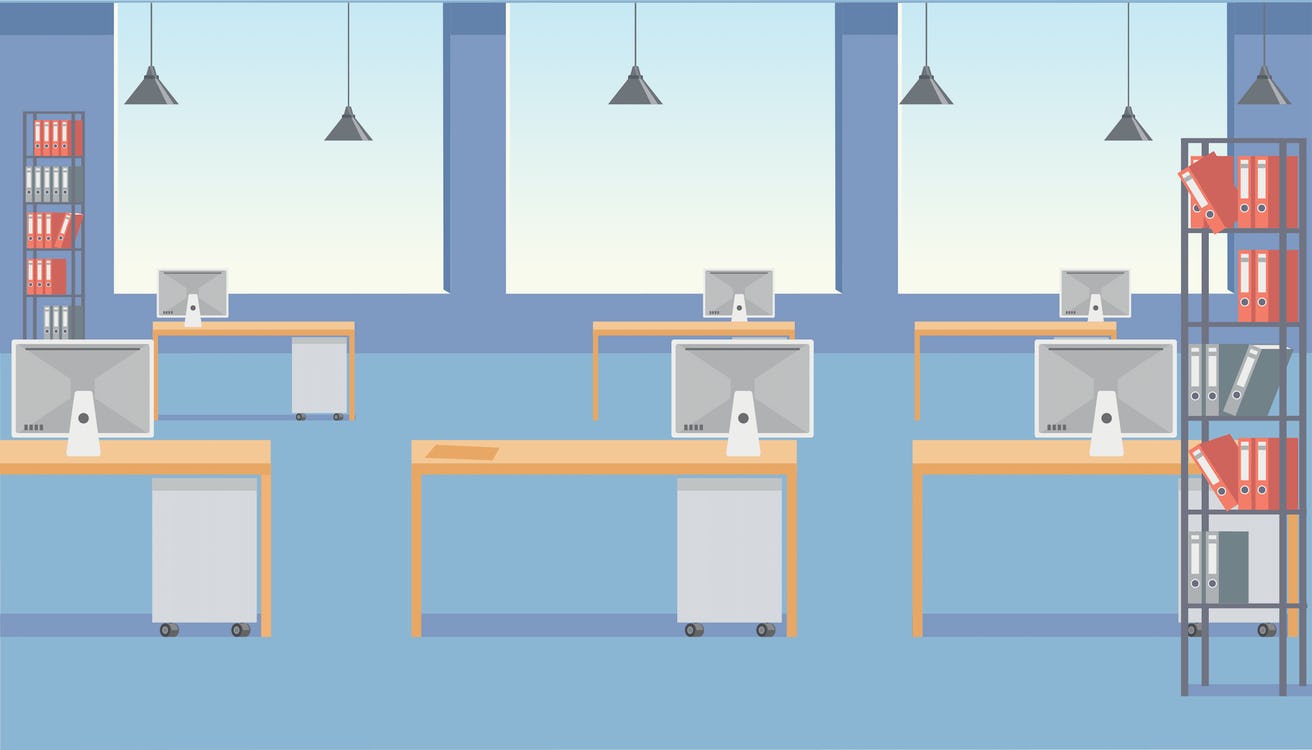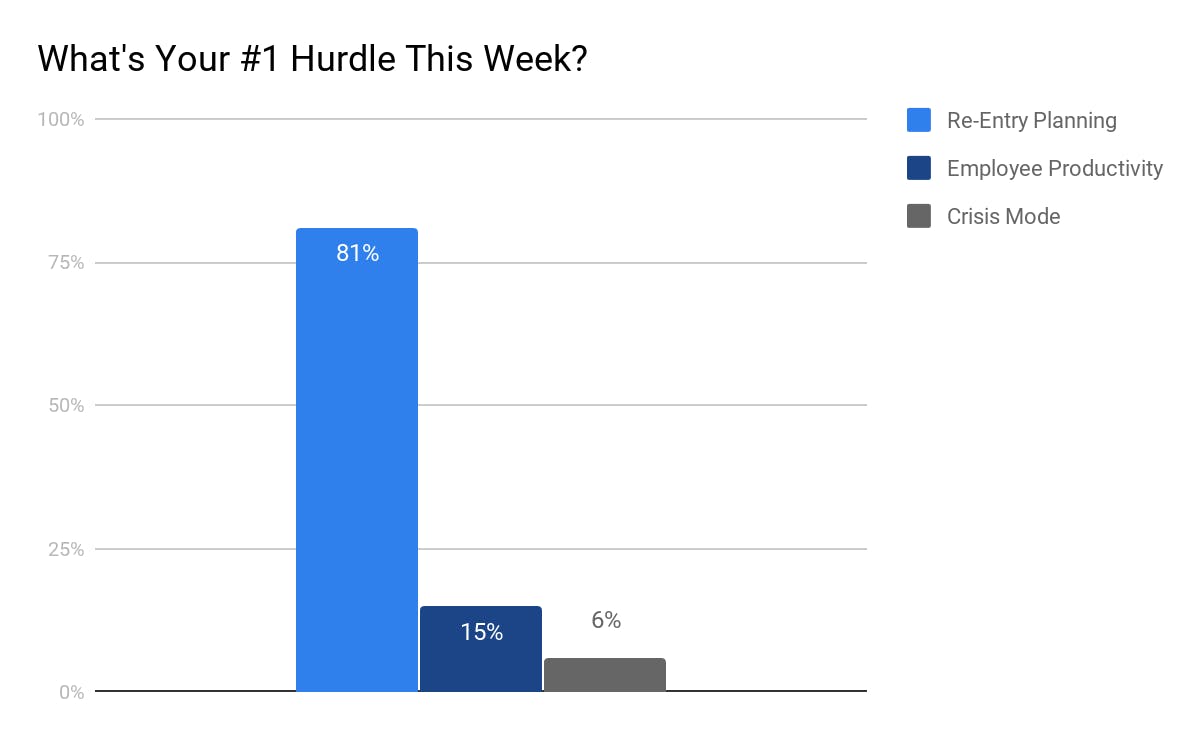Proptech CEOs and 400+ CRE Executives Discuss the Post COVID-19 Workplace

VergeSense is the industry leader in providing enterprises with a true understanding of their occupancy and how their offices are actually being used.
Last Thursday, VergeSense CEO Dan Ryan joined Sam Dunn, CEO of Robin, Eric Graham, CEO of CrowdComfort, and over 400 corporate real estate attendees, on a virtual roundtable discussing how COVID-19 is impacting the workplace.
The discussion kicked off with a pulse check on how attendees are experiencing the largest work-from-home experiment in history. Surprisingly, 96% of attendees noted via virtual polling that the work-from-home set-up was going better than they initially expected for their workforce, not worse.
This data further echoed what the participating CEOs believe will be the lasting impact of the crisis. Although there have been some hiccups with adjusting to working from home and a rush to get business continuity plans in place — it hasn’t been as bad as many thought. And while employees will soon return to work, they will do so with new demands for office settings that allow for choice and flexibility in terms of where — be it at home or anywhere within the office — and when tasks are done. These demands will increase the shift to more agile and Activity-Based-Working environments.
Here are some of the other key takeaways from the roundtable:
Shifting Focus from Crisis Response to Re-entry Planning

As executives have moved past crisis mode and become assured of remote employee productivity, over 81% of attendees noted their biggest current hurdle is planning for re-entry of their workforce to the office. However, the roundtable of CEOs agreed that it will likely be a staggered re-entry for most companies.
Robin’s Sam Dunn noted that his most popular question to ask customers right now is what percentage of their workforce will go back to the office on day one. If customers say 100%, that probably means they aren’t adequately planning for re-entry and the need for initial social distancing in the office. If they say a different percentage, then it’s a good sign they are beginning to plan in the right way.
Overall, Dunn emphasized that he hears two approaches from companies when it comes to a re-entry plan. One is a risk-minimizing approach where companies limit the number of employees from divisions and teams that are allowed to come back to the office. This approach will ensure that an entire department of a company isn't exposed to the virus and out for a considerable amount of time. The second approach is more need-based and focused on allowing small teams that need to collaborate in-person access to office space on rotation. Meanwhile, teams like engineering that may actually be increasing productivity at home can continue working remotely.
VergeSense’s Dan Ryan relayed a story from a major global corporation with offices in Asia that has already started reentering offices. While at first glance, some have hypothesized that the pandemic would curb the use of hot-desks and unassigned seating because of hygiene issues, it may be the opposite. This company found that staggering re-entry was actually much easier to plan within workplaces that already had agile and flex seating in place.
Instead of needing to plan around set office use, or worrying about how to get a specific employee back to their specific chair, the corporation's use of flex desks made it easy to plan for rotations and distancing. Of course, this comes with the needed sanitization in place to ensure desks are cleaned in-between employees using them.
CrowdComfort’s Eric Graham added that the re-entry will take three phases to get back to a new normal. The first will be in the next 1-3 months as a certain number of employees can go back to work in groups or waves until antibody tests become widely available. That could be by department or even alphabetically by name.
Instilling Safety and Confidence for Returning Employees
.png)
A significant aspect of any office re-entry plan has to be focused on instilling confidence in the workforce to return to the office. What if an employee is afraid to come back to work? Graham noted if someone is productive remotely and doesn’t feel safe returning, they should certainly have the option to continue working from home.
The requirements that are needed to instill confidence in returning to the office might be similar to post 9/11 TSA requirements. Dunn spoke about how these requirements gave us long lines, but also gave us collective confidence that we could safely travel again.
The roundtable agreed that a task force needs to be implemented that includes executives from HR, CRE, IT, and Security to tackle the challenge of planning together. Staggering workforce re-entry and adjusting seating arrangements were top of mind for the majority of attendees, with masks and sanitizer availability, touchless surfaces, and cleaning schedule adjustments close behind.
However, these are just the top of the list when it comes to all types of low and high tech options that executives need to be looking at to make office settings as safe as possible. Based on personal client conversations, the roundtable highlighted some of these options.
Low Tech
- Taking chairs out of conference rooms. Or eliminating conference rooms altogether.
- Implementing ‘one-way streets’ in the workplace, similar to what many grocery stores are currently practicing. This may include arrows on the floor or basic signage to avoid contact and high-traffic areas.
- Establishing an elevator strategy. Stairways work for a few story buildings, but with high-rises, enforcing lower capacity for elevators will be needed. Keychain type hooks to open latch doors that can be handed out to employees.
High Tech
- Real-time floor maps that show which areas in a building have already been sanitized.
- Next generation workplace sensors that help ensure safe distancing between employees in the workplace. In fact, VergeSense’s patent-pending, social distancing metrics can measure the actual distance between employees.
- Environmental sensors that analyze humidity, temperature, air quality, C02, etc. Making this information transparent and available to all employees will be a way to instill trust.
- Optimizing cleaning budgets as needs inevitably grow. Using sensors and other tools to automate management of cleaning crews.
The use of technology will also transform traditional roles within facilities. Different executives and business units will likely become more involved in workplace management and require access to actionable data.
It is evident with the initial phase of going back to work that there will be no panacea or silver bullet. Without adequate antibody testing and no current vaccine, even temperature taking to enter the building won’t be foolproof given the asymptomatic spread of COVID-19. That said, new habits need to emerge collectively to tackle this challenge together.
Impact on the Future of Corporate Real Estate
.png)
The roundtable of CEO’s closed the discussion by covering how the COVID-19 crisis will likely impact the future of corporate real estate. A poll of attendees suggests that the pandemic's long-term impacts will mean many companies will reduce (51%) their overall footprint of real estate portfolios rather than increasing (3%) them. Although 46% of attendees admitted, they are still unsure of the long-term consequences of the pandemic to how much office space they own or lease in the future.
Proptech will be a driver in finding ways to reduce real estate footprints, while still keeping workers safe and productive. Ryan discussed how the biggest COVID-19 impact on corporate real estate long-term will be the acceleration of workplace digitization. New trends such as activity-based working and agile working will be pushed forward 5-10 years by responding to the crisis.
Work-from-home has now become viable at scale. More people will be assigned to fewer buildings, but employees will only come in a few times a week, so there will be more space per person. However, only the most advanced sensor technology, like VergeSense, will be capable of providing real-time social distancing metrics to ensure employees are still spaced safely.
Smart buildings will need to learn new skills. Metrics from sensors like ‘workplace collisions’ used to be seen as a positive sign of workplace collaboration by executives. Within the post COVID-19 workplace, these collisions will be a negative. They will need to be tracked and measured to ensure companies are complying with new health guidelines.
Graham added that the target square foot per person will change. Starting 15 or 20 years ago — Accenture was designing buildings for 300 capacity and then assigning 1,000 to the workplace. Following the crisis, we’ll see short-term density decreases. However, in the long-term, companies may be able to assign 2,000 people to that (1,000 person) workplace because the majority of employees are only coming in a few times per week. Therefore the workplace density will be the same or even lower than before.
Dunn shared some thoughts on how the crisis will really change the perceived value of the physical workplace. He believes the office will become a network of spaces rather than one central hub. The spaces will be more purposefully built for precisely the type of experience that certain employees or teams need to access.
Finally, VergeSense CEO Dan Ryan closed with the importance of staying nimble and agile in a world where workplace conditions are rapidly changing. Everyone needs to be comfortable with their 30-60-90-day re-entry plan and be prepared to adapt to changing conditions and new information. No living person has experienced a pandemic such as this, so a collective mindset of rapid innovation are essential in this climate.